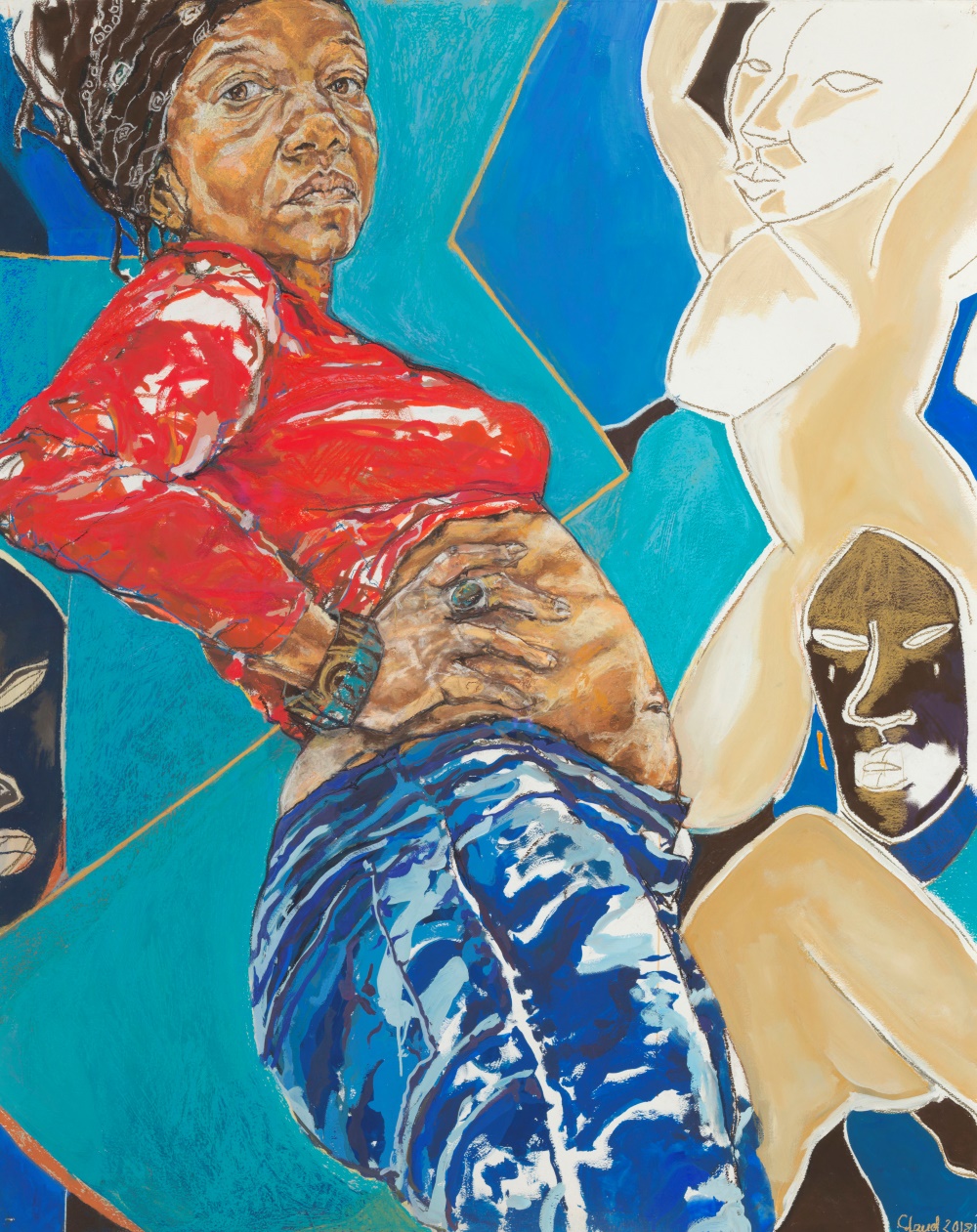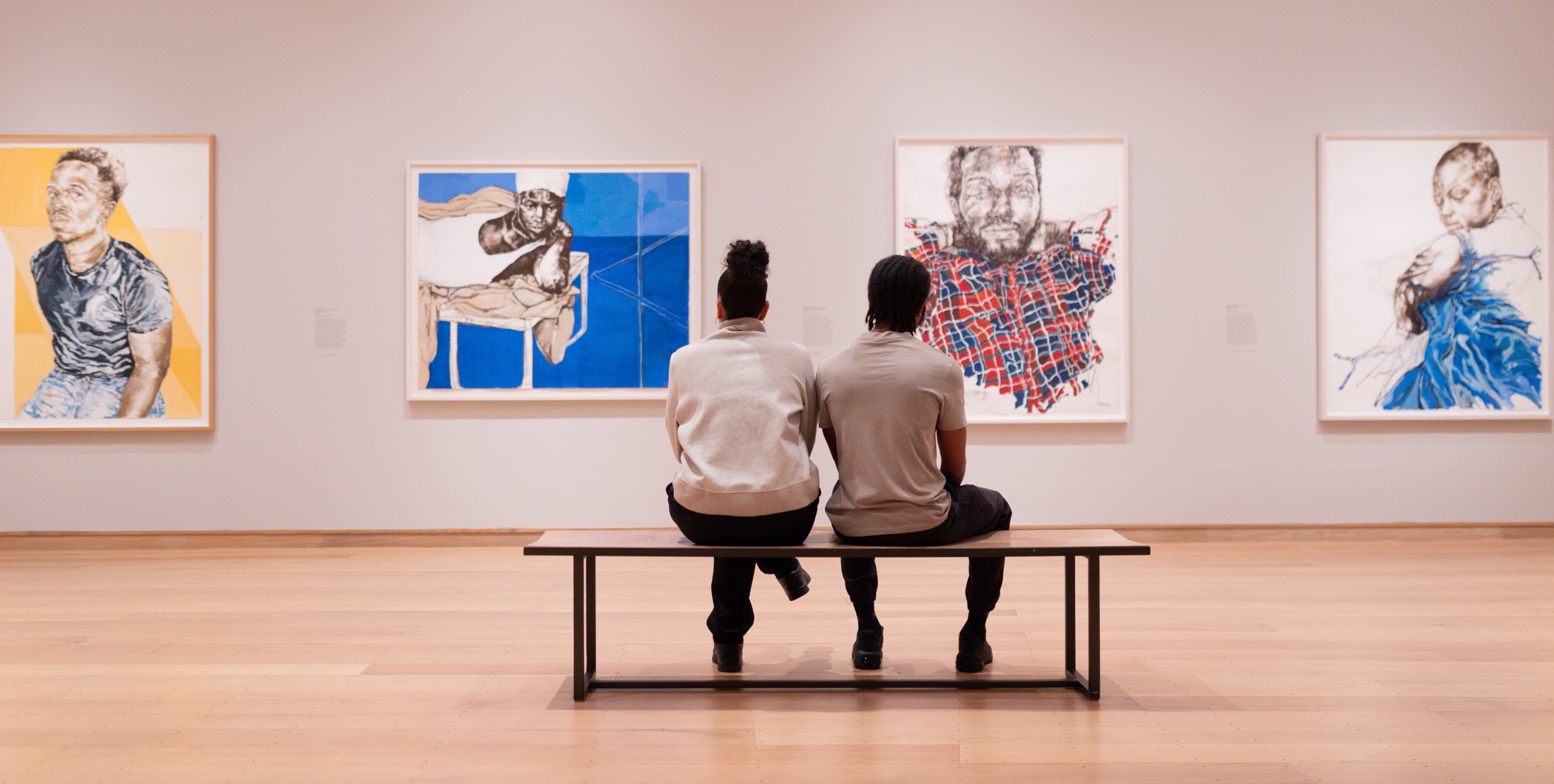
Review: Claudette Johnson’s ‘Presence’ at London’s Courtauld Gallery
A Black woman is standing in side profile, her face tilted towards us, her gaze bold and detached. She is leaning backwards slightly, her firm, confident posture accentuated by a golden line zigzagging across the background. Dancing along with her are African masks and a pale sculpture.
This powerful drawing, titled ‘Standing Figure with African Masks’ (2018), is just one of the captivating pieces featured in Johnson's first major exhibition at The Courtauld Gallery. With its blazing colours, this portrait by British artist Claudette Johnson immediately catches your attention upon entering the show. Given her love of Miles Davis – whose album ‘Kind of Blue’ inspired a work she produced in 2020 by the same name – the rich blue background of ‘Standing Figure with African Masks’ (2018) strikes as a nod to blues and jazz music. You can almost hear the brassy tones of a saxophone reverberating from this strangely mystical work.
Photo 1 - Claudette Johnson, Standing Figure with African Masks, 2018. Pastels and gouache on paper, 163 x 133 cm. Tate, London © Claudette Johnson. Photo: Tate; Photo 2 - Claudette Johnson, Kind of Blue, 2020. Gouache, pastel ground, pastel, 121.92 x 152.4 cm. Private collection © Claudette Johnson. Image courtesy the artist and Hollybush Gardens, London. Photo: Andy Keate
Johnson's work embodies the essence of jazz — freedom, both physical and musical. Her work seeks to give Black women and, more recently, Black men, breathing space. In her large-scale drawings, the figures emanate a magnetic presence, gazing back at us with animated eyes that conceal a profound interior life. In her art, Black women and men are not objects of our gaze; they are subjects in their own right.
Claudette Johnson’s work: A dedication to the recovery of humanity
Her work is fundamentally a recovery of humanity,
says Dr Dorothy Price, co-curator of Claudette Johnson: Presence and professor of Modern and Contemporary Art and Critical Race History at The Courtauld.
When she was a student at the Wolverhampton School of Art in the 1980s, Johnson was exposed to the invisibility of Black people in the art world. As one of the few artists of colour at the university, she felt woefully isolated. She started to think about Black people in space, and dedicated herself to changing their role within the British art establishment.
At the onset of her career, Johnson joined the BLK Art Group, a newly formed association of young Black artists who redefined Black art. She also pioneered Black British feminism in the visual arts and, in 1982, gave a talk at the First National Black Arts Conference that was pivotal in the emergence of the Black feminist art movement.
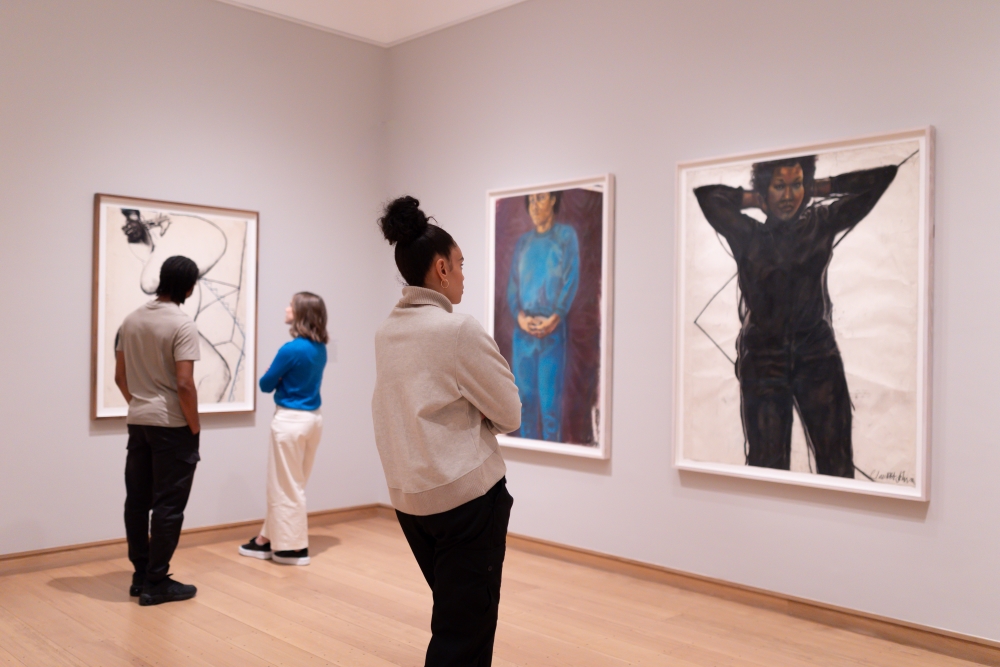 Claudette Johnson's 'Presence' at The Courtauld Gallery. Installation View. Photo: Fergus Carmichael
Claudette Johnson's 'Presence' at The Courtauld Gallery. Installation View. Photo: Fergus CarmichaelThe issues that Johnson was grappling with in the 1980s are woven into her practice. This was a prolific decade for the twenty-something artist. Her work featured in several era-defining exhibitions in London, including Five Black Women at the Africa Centre in 1983, Black Women Time Now at the Battersea Arts Centre in 1984, and The Thin Black Line at the Institute of Contemporary Arts in 1985.
Nearly 40 years later, carefully selected drawings from this formative period in Johnson’s career have been brought together in the first room of Claudette Johnson: Presence at the Courtauld. The diverse body of work offers a glimpse into her experimentation with pictorial approaches, which drew from 19th century painters, such as Édouard Manet, Edgar Degas and Pablo Picasso.
In ‘I Came to Dance’ (1982) – an abstract drawing of a nude woman – Johnson started to play with simple lines. The subject’s body is partially revealed through details on her right leg and the lower half of her face. The rest is as if veiled, with only a few, thoughtfully placed curves outlining her figure. These sways of abstraction, inspired by Picasso’s cubism, create dynamism and tension.
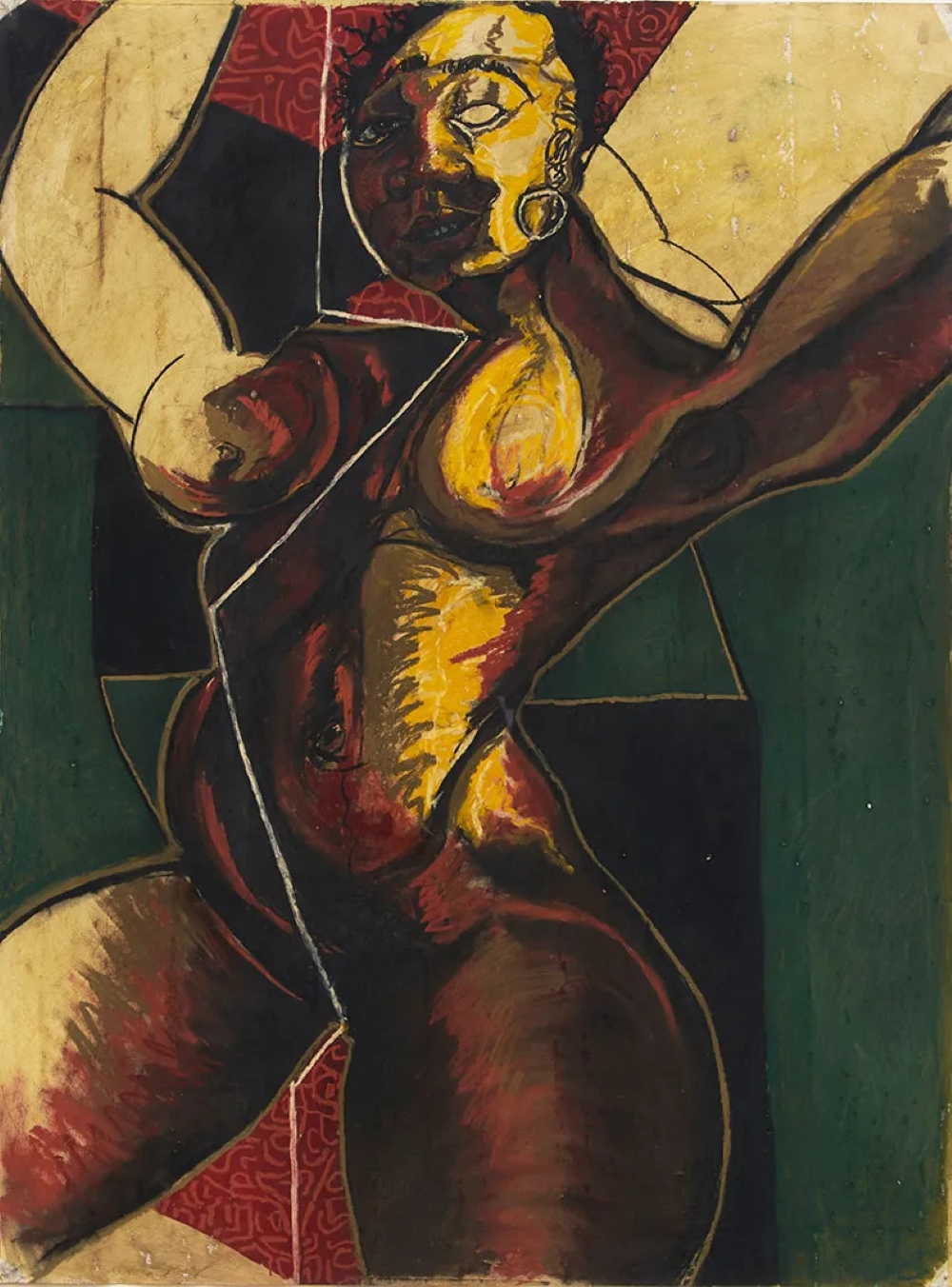 Claudette Johnson, And I Have My Own Business In This Skin, 1982. Pastel and gouache paint on paper, 143 x 111 cm. Sheffield Museums © Claudette Johnson. Image courtesy the artist and Modern Art Oxford. Photo: Ben Westoby
Claudette Johnson, And I Have My Own Business In This Skin, 1982. Pastel and gouache paint on paper, 143 x 111 cm. Sheffield Museums © Claudette Johnson. Image courtesy the artist and Modern Art Oxford. Photo: Ben WestobyJohnson also subverts Picasso’s objectification of Black women. Her refutation of the influential artist’s dehumanising portraits is palpable in the arresting ‘And I have My Own Business In This Skin’ (1982). The abstract representation of a nude woman and warm colours are intended to mirror Picasso’s ‘Les Demoiselles D’avignon’ (1907), in which a group of naked women stare at the viewer with glazed, troubled eyes. Johnson’s subject, on the other hand, confidently launches herself forward, imposing the fullness of her strong body. By inserting herself in Picasso’s work, Johnson is interrupting the fiction of Blackness and telling a new story, one that is charged with humanity and feeling.
Johnson’s work never ceases to evolve. As Price points out, the drawings in the second room of the exhibition, which were produced in the last eight years,
grow in richness and complexity.
The subjects exude more spirit and character, yet the drawings often have an unfinished quality, such as ‘Reclining Figure’ (2017). Inspired by Johnson’s mother, who would rest after a long day’s work, the piece illustrates a woman lying on her side. Her loosely drawn dress – evoking a landscape with its mountain-like creases – consumes most of the space.
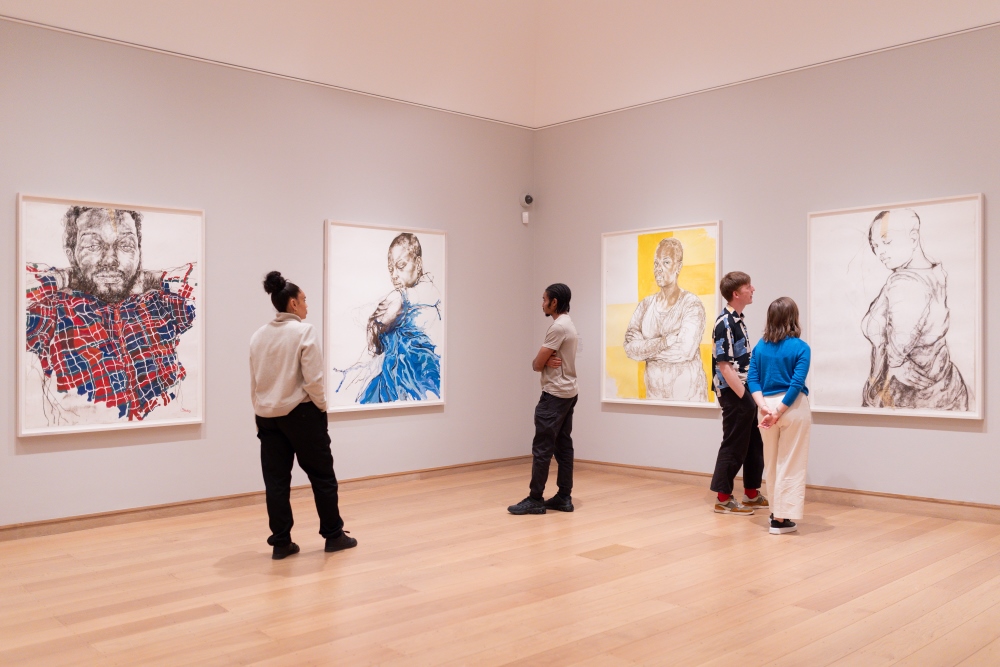 Claudette Johnson's 'Presence' at The Courtauld Gallery. Installation View. Photo: Fergus Carmichael
Claudette Johnson's 'Presence' at The Courtauld Gallery. Installation View. Photo: Fergus CarmichaelWhat I love about this work is the fact that the weight is achieved from just lines,
says Price.
It’s quite brave to leave such a vast expanse of negative space.
As one of the greatest figurative artists of her generation, it was about time for Johnson to have her first major exhibition. At 64-years-old, her work is finally granted the recognition it deserves. She is in the exciting process of moving to a bigger studio, promising more breath-taking, large scale drawings in the coming years.
For more insights into the world of art, check out our Q&A with curator Andrea Tarsia on the Royal Academy’s major Marina Abramović show.
Credits for the Main photo: Claudette Johnson's 'Presence' at The Courtauld Gallery. Installation View. Photo: Fergus Carmichael

